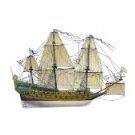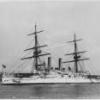Supplies of the Ship Modeler's Handbook are running out. Get your copy NOW before they are gone! Click on photo to order.
×
-
Posts
2,227 -
Joined
-
Last visited
Reputation Activity
-
 EJ_L got a reaction from md1400cs in Royal Louis 1780 by EJ_L - Mamoli - Scale 1:90
EJ_L got a reaction from md1400cs in Royal Louis 1780 by EJ_L - Mamoli - Scale 1:90
Finally getting back into the shipyard. Should be much more regular with updates again and I am ready to build!
While I have been busy over the past few months, I have managed to get in small bits of build time and have been particularly active this week resulting in all three lower masts and tops built. Neither masts nor tops are glued yet, just rough fitted. I will build all the masts, caps, crosstrees, etc. then switch to rigging. After all this time it will be nice to start going vertical.
-
 EJ_L got a reaction from Prowler901 in Royal Louis 1780 by EJ_L - Mamoli - Scale 1:90
EJ_L got a reaction from Prowler901 in Royal Louis 1780 by EJ_L - Mamoli - Scale 1:90
Bowsprit assembly complete and installed. Missing a few blocks still but those will install when the rigging commences. Foremast up next.
-
 EJ_L got a reaction from Prowler901 in Royal Louis 1780 by EJ_L - Mamoli - Scale 1:90
EJ_L got a reaction from Prowler901 in Royal Louis 1780 by EJ_L - Mamoli - Scale 1:90
Finally getting back into the shipyard. Should be much more regular with updates again and I am ready to build!
While I have been busy over the past few months, I have managed to get in small bits of build time and have been particularly active this week resulting in all three lower masts and tops built. Neither masts nor tops are glued yet, just rough fitted. I will build all the masts, caps, crosstrees, etc. then switch to rigging. After all this time it will be nice to start going vertical.
-
 EJ_L got a reaction from DARIVS ARCHITECTVS in Royal Louis 1780 by EJ_L - Mamoli - Scale 1:90
EJ_L got a reaction from DARIVS ARCHITECTVS in Royal Louis 1780 by EJ_L - Mamoli - Scale 1:90
Some work on the bowsprit mast. As with all masts and yards, I’m trying to attach as many blocks and other components as possible before securing to the ship.
This is made trickier as I intend to have sails but of course the rigging plans do not include that information. To figure out what is needed, a lot of consulting other books and examples is taking place for each sail to try to find all the components needed. Even more fun is that I am used to building ships with spritsail topmasts, and this one has a jib boom and sail. My accumulated knowledge of the former is not helping right now…
-
 EJ_L got a reaction from DARIVS ARCHITECTVS in Royal Louis 1780 by EJ_L - Mamoli - Scale 1:90
EJ_L got a reaction from DARIVS ARCHITECTVS in Royal Louis 1780 by EJ_L - Mamoli - Scale 1:90
Been a while since I have updated but I have been slowly making progress. All of the exposed guns have been rigged.
Next up will be the channels and then gun port lids.
-
 EJ_L got a reaction from Patrick B in Royal Louis 1780 by EJ_L - Mamoli - Scale 1:90
EJ_L got a reaction from Patrick B in Royal Louis 1780 by EJ_L - Mamoli - Scale 1:90
Success was had on another 20' length of rope, this one .080" or ~ 2mm diameter. Will likely be used for anchor cable on R.L. This required 4 threads of the Mara 30 size thread for each strand and 4 strands, for a total of 16 threads being stretched. Start to finish took me about 45 minutes, most of which was initial set up.
I tie my threads one at a time. It is time consuming and I may look into finding or making a bracket of some sort that can hold multiple spools of thread so I can tie off multiple eyelets at once. For ease of access, I start at the lowest eyebolt then move to the rear most, foremost, and finally top so I am not trying to work over the threads.
Once they are all tied on, you will have something that looks like this. it is a good idea to trim any overly-long threads so they do not tangle in the gears. Short tails, 1" or less are fine however.
When tying, you want to try to keep even tension on the threads, but with poly thread, it is a bit more forgiving. Apologies for the fuzzy pictures, really need a second person helping to do this, but as you can see in the picture, my bottom 4 threads has one that is far away from the others especially compared to the gaps on the ones in the middle. The middle ones will be fine as they twist up, but the bottom I would tighten.
Note: If a thread slips from your fingers before it is tied off, it is a good idea to pull the thread fully out of the stretched ropes back to the eyebolt and then re-stretch. Otherwise, you risk having the thread become tangled around the other threads from when it shot from your grasp. This happened to me a few times.
Time to twist. In a counter clockwise rotation, twist the threads, allowing them to tighten merge into one strand so that there are 4 strands. Even if you are only doing a 1 thread per strand lay, you still need to do this step only rotate the drill clockwise for single threads and C.C. for multi-threads.
Time to combine the strands. Rule of thumb here is whichever way, (clockwise or counter) that you twisted the threads, twist the strands. Start slowly, hand spin the first few rotations to see that everything is following as it should. You can see the center of the line merging together.
The lay is not very tight yet, but all the strands are going in the correct direction. Time to add speed.
Run the rope walk till the lines become tensioned properly. I recommend watching Chuck's YouTube videos as this is easier to show then write, and honestly it takes practice and experience to learn, of which I am still figuring out. I tend to over tighten. The line should look even and tight with only an inch or two free in front of the eyebolts on either end. I moisten the rope with water on my fingers while it is stretched out. Beeswax can also be used. This helps to set the threads and eliminate the "fuzzys" (technical term) that threads can develop.
Hold tight to the rope before cutting so it does not shoot off across the room, tangling itself up. If laid up right you should get something like this once free. The only loose ends should be the 1-2 inches where the strands were tied to the eyebolts. The rest should remain a tightly laid up rope.
If you end up with something of this nature when you release the tension on the rope and allow it to recoil, this means it is over-twisted, a comon and easy to correct issue. Under-tension results in the rope fraying and falling apart. Over-tension is easily fixed by running your fingres repeatedly down the length of the rope, allowing it to unwind til it lays limp and untangled.
Rope after I worked the over-twists out.
Next up, I lightly coiled the rope around my spread fingers to make a gentle coil that will lay nicely on the oven try I use to bake at 350 for about 4 minutes. Watch it closely as time varies with oven and you do not want it to melt. Remember this is poly-rope not cotton.
Once out of oven, and cooled, (Do not grab rope immediately. It was in a hot oven, it will be hot.) it should lay like natural rope and is ready to be wound onto something or coiled and placed in bag for storage. I wrap mine around plastic bobbins and have them sorted by size and color on hooks.
The pass/fail test is at the end, though if it did not unravel when cut from the eyebolts, chances are excellent that it is fine now, is if you take a sharp knife and cut, the end should be clean with no fraying. This one is good!
Good luck to all, and I hope this helps!
-
 EJ_L got a reaction from Patrick B in HMS Sovereign of the Seas by Sjors - DeAgostini - 1:84
EJ_L got a reaction from Patrick B in HMS Sovereign of the Seas by Sjors - DeAgostini - 1:84
Great fix. Had you not shown us the whoops, we never would have known it was damaged. Looks like you are back on track and moving along again!
-
 EJ_L got a reaction from Patrick B in HMS Sovereign of the Seas by Sjors - DeAgostini - 1:84
EJ_L got a reaction from Patrick B in HMS Sovereign of the Seas by Sjors - DeAgostini - 1:84
Planking those areas will make the model look a lot better. Good job on that.
That is rough looking wood. I was curious as to the quality of the lumber provided for the planking. That can be used for framing or areas that won't be seen but I hope the wood for the upper decks and the hull is a lot better.
-
 EJ_L got a reaction from Patrick B in HMS Sovereign of the Seas by Sjors - DeAgostini - 1:84
EJ_L got a reaction from Patrick B in HMS Sovereign of the Seas by Sjors - DeAgostini - 1:84
Looking good!
I don't think I could use food as weights as my weights would constantly be getting lighter...
-
 EJ_L got a reaction from Patrick B in Royal Louis 1780 by EJ_L - Mamoli - Scale 1:90
EJ_L got a reaction from Patrick B in Royal Louis 1780 by EJ_L - Mamoli - Scale 1:90
Hull work has resumed. Spent some time working filler and sanding the hull and now I’ve got her to where I can start working on planking.
With that done, I laid out the wale lines and making sure both sides are an even match. Now I get to punch the gun ports. Once those are opened up, I can install the framing. I’m thinking of using bloodwood to simulate the red paint of the gun port frames and inside the lids. I would like to avoid using paints on the build with the exceptions of the carvings.
More to follow in the coming days and weeks. Good to be back on this build. 😀
-
 EJ_L got a reaction from Knocklouder in America 1851 by mojofilter - FINISHED - Mamoli - Scale 1:66 - First wooden ship build
EJ_L got a reaction from Knocklouder in America 1851 by mojofilter - FINISHED - Mamoli - Scale 1:66 - First wooden ship build
Well done indeed! A beautiful ship and something to be very proud of. Now you get to enjoy that feeling of completing a ship. Sit back, have a drink and let the tension from building her fall away. Now you can just relax and admire her and let your mind start thinking on the next project.
As nice as America came out I am looking forward to seeing what you can do with Cutty Sark!
-

-

-
 EJ_L reacted to archjofo in La Créole 1827 by archjofo - Scale 1/48 - French corvette
EJ_L reacted to archjofo in La Créole 1827 by archjofo - Scale 1/48 - French corvette
Hello Gerard,
no problem. Discussion was factual, and was not uninteresting.
Now back to the real problems of the world ...
to the yard arms of La Creole ... 😁
-
 EJ_L reacted to archjofo in La Créole 1827 by archjofo - Scale 1/48 - French corvette
EJ_L reacted to archjofo in La Créole 1827 by archjofo - Scale 1/48 - French corvette
Continued: Clarifying the yardarms
After an extensive web search I came across this book: "Description de l'art de la Mâture" (published in 1778) by Charles Nicolas Romme.
Below are excerpts of the yardarms: Fig. 38 clearly explains the "oval" cross-sections in the area of the cleats on the yardarms.
In connection with the design of the yardarms for the La Créole, the question of the chronological classification naturally arises: The Le Rivoli is from 1810, the Le Sphinx from 1829 and the Le Neptune from 1836. In this respect, this is for the epoch of the La Créole applicable.
Apparently I'm not the only one who stumbled across this problem. So thanks again to G. Delacroix who gave me the crucial hint.
For my model, however, the question now arises as to how I can reconcile this detail with the drawings by J. Boudriot. I would prefer to stick to the original model. Unfortunately I don't have any meaningful detailed pictures. Ultimately, I will have to make a decision about this detailed design, even with the risk that it will not be entirely correct.
-
 EJ_L reacted to archjofo in La Créole 1827 by archjofo - Scale 1/48 - French corvette
EJ_L reacted to archjofo in La Créole 1827 by archjofo - Scale 1/48 - French corvette
@G. Delacroix
Thank you in advance for the valuable information.
I obviously misinterpreted the drawing by J. Boudriot. Now following your hint I see that it only works graphically as an oval.
I also researched my picture collection again and found a picture of the Le Neptune 1836 from the Musée national de la Marine Paris. A yard can be seen there as a reserve, comparable to that of the Rivoli.
Allowed me to include your drawing and that of J. Boudriot in this example.
Source: Musée national de la Marine Paris, G. Delacroix, J. Boudriot
I also found a very interesting picture of a yardarm from the mizzen topsail yard of Le Sphinx 1829.
Source: Musée national de la Marine Paris
Will now try to make the yardarms of the topsail yards for the La Créole in the oval version according to the drawing by J. Boudriot.
I am very open and grateful for further hints and examples.
-
 EJ_L reacted to G. Delacroix in La Créole 1827 by archjofo - Scale 1/48 - French corvette
EJ_L reacted to G. Delacroix in La Créole 1827 by archjofo - Scale 1/48 - French corvette
Hello,
Please note that the cleats on the yardarms are not square, they have this shape (the front part of the yard is at the top of the picture):
Example on Le Rivoli :
GD
-
 EJ_L reacted to archjofo in La Créole 1827 by archjofo - Scale 1/48 - French corvette
EJ_L reacted to archjofo in La Créole 1827 by archjofo - Scale 1/48 - French corvette
Continuation: Making the yards - Fore topsail yard - Vergue de petit hunier
After making the lower yards, I started working on the topsail yards. In contrast to the yardarms of other navies in the comparable period, the ones of the French navy seem adventurous. Probably due to a higher flexibility of the sailing maneuvers, these topsails are a certain challenge for the modeler, as can be seen on the following pictures for the mizzen topsail -, fore topsail - and main topsail yard of the La Créole.
Source: Monograph La Creole by J. Boudriot
Unfortunately, I do not have sufficiently sharp images of the original model from which one could derive further details. So I rely on the plan drawing of the monograph except for the formation of the studding sail booms at the yards of the mizzen mast. For this I again follow the original model, which clearly shows no studding sail booms at the mizzen mast. Further research shows that many contemporary French models also do not have studding sail booms at the yards of the mizzen mast. John Harland in his book "Seamanship in the Age of Sail" writes about studding sails on the mizzen mast that in his opinion they were neither popular nor particularly practical.
After several attempts, the fore topsail yard seems to have succeeded according to the drawing specifications, at least I am satisfied.
The next picture shows the fore topsail yard compared to the main yard, where the yard arm has a simpler design.
The drawing with dimensions for the main topsail yard is already available.
Soon it will go further ...
-
 EJ_L reacted to archjofo in La Créole 1827 by archjofo - Scale 1/48 - French corvette
EJ_L reacted to archjofo in La Créole 1827 by archjofo - Scale 1/48 - French corvette
@Gahm
@matiz
@FriedClams
@Vladimir_Wairoa
@dvm27
Hello,
I am very grateful for your interest and the nice comments, as well as for the many LIKES. That motivates immensely.
Continuation: Production of the yards - Vergues
We continued with the production of the yards. With the help of G. Delacroix I was able to clarify a few questions about the dimensions of the yards. Accordingly, I used the following table for the dimensions of the masts, yards and spars of the "La Blonde", which is identical in construction to the "La Créole".
Source: Monograph on La Créole by J. Boudriot, page 56
There, among other things, the diameters are given in addition to the lengths. As a rule, the small diameter of a yard is 2/5 of the large diameter, as I could learn from G. Delacroix.
As you can see on the following pictures, the lower yards with the studding sail booms have been made so far in the meantime. Various details on the yard arms, such as for the installation of sheaves for the sheets still require final clarification.
Also with the studding sail booms there are still questions about details, as shown in the following example of the model of the "Le Cotre 1830".
I would be very grateful for any suggestions and hints.
Source: Modèles Historiques au Musée de la Marine - Volume 2 - Jean Boudriot
To be continued ...
-
 EJ_L reacted to Hubac's Historian in Soleil Royal by Hubac's Historian - Heller - An Extensive Modification and Partial Scratch-Build
EJ_L reacted to Hubac's Historian in Soleil Royal by Hubac's Historian - Heller - An Extensive Modification and Partial Scratch-Build
As usual, David - you are right-on-point. Yes, I was thinking the same thing.
Thank you, Michael!
-
 EJ_L reacted to 72Nova in Soleil Royal by Hubac's Historian - Heller - An Extensive Modification and Partial Scratch-Build
EJ_L reacted to 72Nova in Soleil Royal by Hubac's Historian - Heller - An Extensive Modification and Partial Scratch-Build
Jaw dropping details as usual, very, very nice work Marc!👍
Michael D.
-
 EJ_L reacted to druxey in Soleil Royal by Hubac's Historian - Heller - An Extensive Modification and Partial Scratch-Build
EJ_L reacted to druxey in Soleil Royal by Hubac's Historian - Heller - An Extensive Modification and Partial Scratch-Build
Impressive. Marc. Might I suggest thinning the angels' lower feet a bit, though? They ain't hobbits!
-
 EJ_L reacted to yancovitch in Soleil Royal by Hubac's Historian - Heller - An Extensive Modification and Partial Scratch-Build
EJ_L reacted to yancovitch in Soleil Royal by Hubac's Historian - Heller - An Extensive Modification and Partial Scratch-Build
where's your thumb...we need your thumb to show how tiny they are😁....super duper.....the lines flow so nicely
-
 EJ_L reacted to Hubac's Historian in Soleil Royal by Hubac's Historian - Heller - An Extensive Modification and Partial Scratch-Build
EJ_L reacted to Hubac's Historian in Soleil Royal by Hubac's Historian - Heller - An Extensive Modification and Partial Scratch-Build
It turns out that coaching my son’s 5th grade CYO basketball team has been more involved than I anticipated; owing to the pandemic, we are essentially starting from scratch, so I have spent quite a lot of time finding good fundamentals drills, while I learn the broad-strokes of the Pack-Line defense. It is all good fun, but it has cut into ship time.
I did manage to finish up my starboard bow angel:
I did a final/final fitting of the headrails and their supports. Those have now been masked, primed and I’ve begun putting them into colors.
Per Nigel’s suggestion, I am filling-in the missing stair treads on the lower beakhead bulkhead, where the turret seats of ease used to be.
I made a cardboard pattern for the forward terminus of the head grating. I’ve found that saturating this thin card with common CA (thin) makes it into a durable pattern:
I made a rub-tracing of the middle headrail profile, so that I could pattern the arcing slats of the grating.
I am also very happy with how this representation of scroll heads came out, in simulation of the headrail supports actually finishing beneath the lowest headrail:
As these are thoroughly impossible to carve at this scale, I make these from two diameters of styrene rod. It’s a little fiddly to mate the beveled end of the larger diam. rod to that of the smaller diam. rod, but I found that touching my knife point to a drop of liquid styrene cement enabled me to pick these tiny bits up and place them onto a glue spot where they belong.
I’ll be painting for some time, but soon the whole head structure will begin to come together.
Thank you for stopping by.
-
 EJ_L got a reaction from coxswain in Royal Louis 1780 by EJ_L - Mamoli - Scale 1:90
EJ_L got a reaction from coxswain in Royal Louis 1780 by EJ_L - Mamoli - Scale 1:90
Lower foremast shrouds are in place. Ratlines are up next.






